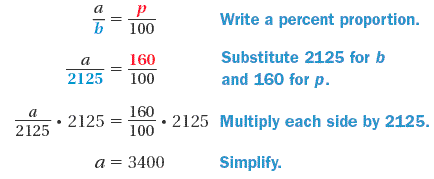Percent Equations
Percent Equations
Use multiplication to find the percent of a number when the percent and the original number (a.k.a. "base") are given.
Example:
Find 3% of $15,000.
Steps:
1. Confirm the percent and the base are given.
2. Convert the percentage to a decimal or fraction with a denominator of 100.
(In most cases, converting the percentage to a decimal makes multiplication easier)
3. Multiply these numbers to find the new amount.
The amount is $450.
Percent Equations
The basic percent equation is:
Percent × Base Number = New Number
Also, certain English words have the following mathematical symbols:
- of is written as "×" (multiplication)
- is is written as "=" (equals)
- what is written as "n" (the unknown number)
Example
What is 5% of 20?
n = 5% × 20
n = 0.05 × 20
n = 1
You can find a percent when the base and amount are given by using the formula:
Example
What percent of 4 is 3?
Percent × base = amount
n × 4 = 3
You can find the base number when the percent and amount are given by using the following formula:
Percent × Base Number = New Number
Example15% of what is $300?
Percent × base = amount
15% × n = 300
0.15 × n = 300
n = $2000
Using a Proportion
You can also use a proportion to solve a percent problem. The percent is written as a ratio , and the other ratio is expressed as , or . Set the ratios equal and solve.
Example
Thanks to a donor, your department's budget for this year's supplies is 160% of last year's budget. If last year's budget was $2,125.00, what is this year's budget?Solution

This year's budget is $3,400.